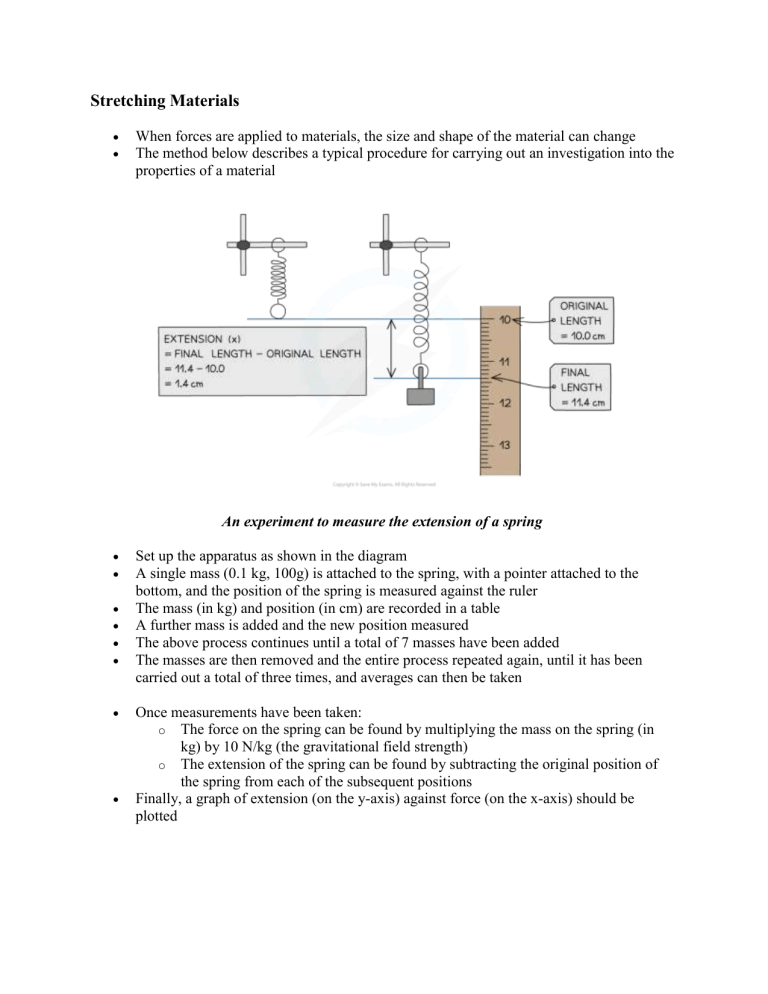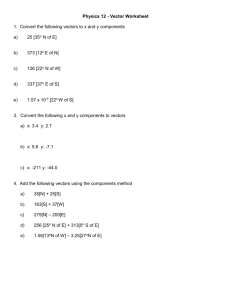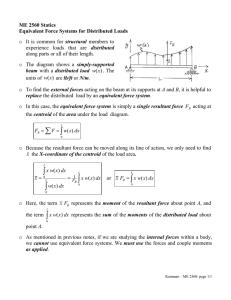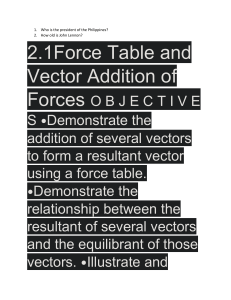
Stretching Materials When forces are applied to materials, the size and shape of the material can change The method below describes a typical procedure for carrying out an investigation into the properties of a material An experiment to measure the extension of a spring Set up the apparatus as shown in the diagram A single mass (0.1 kg, 100g) is attached to the spring, with a pointer attached to the bottom, and the position of the spring is measured against the ruler The mass (in kg) and position (in cm) are recorded in a table A further mass is added and the new position measured The above process continues until a total of 7 masses have been added The masses are then removed and the entire process repeated again, until it has been carried out a total of three times, and averages can then be taken Once measurements have been taken: o The force on the spring can be found by multiplying the mass on the spring (in kg) by 10 N/kg (the gravitational field strength) o The extension of the spring can be found by subtracting the original position of the spring from each of the subsequent positions Finally, a graph of extension (on the y-axis) against force (on the x-axis) should be plotted A graph of force against extension for a metal spring Hooke's Law Hooke’s law states that: o The extension of a spring is proportional to the applied force (where k is the spring constant, which represents how stiff a spring is) Many other materials (such as metal wires) also obey Hooke’s law Hooke’s law is associated with the initial linear (straight) part of a force-extension graph Objects that obey Hooke’s law will return to their original length after being stretched If an object continues to be stretched it can be taken past the limit of proportionality (sometimes called the elastic limit). At this point the object will no longer obey Hooke’s law and will not return to its original length The spring on the right has been stretched beyond the limit of proportionality Exam Tip A relationship is said to be proportional if the graph is a straight line going through the origin.If a graph is a straight line but does not go through the origin the relationship is said to be linear. Resultant Force When several forces act on a body, the resultant (overall) force on the body can be found by adding together forces which act in the same direction and subtracting forces which act in opposite directions: Diagram showing the resultant forces on three different objects When the forces acting on a body are balanced (i.e. there is no resultant force), the body will either remain at rest or continue to move in a straight line at a constant speed When the forces acting on a body are balanced the body will remain at rest or continue to travel at a constant speed in a straight line Friction Friction is a force that opposes the motion of an object caused by the contact (rubbing) of two surfaces. It always acts in the opposite direction to the direction in which the object is moving Friction opposes the motion of an object Air resistance (sometimes called drag) is a form of friction caused by a body moving through the air Friction (including air resistance) results in energy loss due to the transfer of energy from kinetic to internal (heat) Exam Tip The resultant force is sometimes also known as the net force or the unbalanced force.Avoid referring to air resistance as wind resistance or air pressure – these are incorrect terms and will lose you marks if you use them when you actually mean air resistance. Forces & Motion When an unbalanced (resultant) force acts on an object, it can affect its motion in a number of ways: o The object could speed up o The object could slow down o The object could change direction A resultant force can cause an object to speed up, slow down or change direction Acceleration Force, mass and acceleration are related by the following equation: force = mass × acceleration f=m×a You can rearrange this equation with the help of the formula triangle: Use the formula triangle to help you rearrange the equation The greater the force, the greater the acceleration (for a given mass) For a given force, the smaller the mass the greater the acceleration Exam Tip If you are trying to find the acceleration check that you know both the unbalanced (resultant) force and the mass of the object. If you don’t, you might need to calculate the acceleration using a different equation. Changing Direction When a force acts at 90 degrees to an object’s direction of travel, the force will cause that object to change direction When the two cars collide, the first car changes its direction in the direction of the force If the force continues to act at 90 degrees to the motion, the object will keep changing its direction (whilst remaining at a constant speed) and travel in a circle This is what happens when a planet orbits a star (or satellite orbits a planet) The Moon is pulled towards the Earth (at 90 degrees to its direction of travel). This causes it to travel in a circular path The force needed to make something follow a circular path depends on a number of factors: o The mass of the object (a greater mass requires a greater force) o The speed of the object (a faster-moving object requires a greater force) o The radius of the circle (a smaller radius requires a greater force) The Moment of a Force A moment is the turning effect of a force Moments occur when forces cause objects to rotate about some pivot The size of the moment depends upon: o The size of the force o The distance between the force and the pivot The moment of a force is given by the equation: Moment = Force × perpendicular distance from the pivot Moments have the units newton centimetres (N cm) or newton metres (N m), depending on whether the distance is measured in metres or centimetres Diagram showing the moment of a force causing a block to topple Some other examples involving moments include: o Using a crowbar to prize open something o Turning a tap on or off o Opening or closing a door The Principle of Moments The principle of moments states that: o For a system to be balanced, the sum of clockwise moments must be equal to the sum of anticlockwise moments Diagram showing the moments acting on a balanced beam In the above diagram: o Force F2 is supplying a clockwise moment; o Forces F1 and F3 are supplying anticlockwise moments Hence: F2 x d2 = (F1 x d1) + (F3 x d3) Example of The Principle of Moments The principle of moments doesn’t just apply to seesaws – it is important in many other situations as well such as, for example, a shelf: To prevent the shelf from collapsing, the support must provide an upward moment equal to the downward moment of the vase Equilibrium Defined The term “equilibrium” means that an object keeps doing what it’s doing, without any change Therefore: o If the object is moving it will continue to move (in a straight line) o If it is stationary it will remain stationary o The object will also not start or stop turning The above conditions require two things: o The forces on the object must be balanced (there must be no resultant force) o The sum of clockwise moments on the object must equal the sum of anticlockwise moments (the principle of moments) When the forces and moments on an object are balanced, the object will remain in equilibrium If the above two conditions are met, then the object will be in equilibrium Demonstrating Equilibrium A simple experiment to demonstrate that there is no net moment on an object in equilibrium involves taking an object, such as a beam, and replacing the supports with newton (force) meters: Several forces act on a supported beam, including the mass of the beam and the mass of an object suspended from it The beam in the above diagram is in equilibrium The various forces acting on the beam can be found either by taking readings from the newton meters or by measuring the masses (and hence calculating the weights) of the beam and the mass suspended from the beam The distance of each force from the end of the ruler can then be measured, allowing the moment of each force about the end of the ruler to be calculated It can then be shown that the sum of clockwise moments (due to forces F2 and F3) equal the sum of anticlockwise moments (due to forces F1 and F4) Finding the Centre of Mass The centre of mass of an object (sometimes called the centre of gravity) is the point through which the weight of that object acts For a symmetrical object of uniform density (such as a symmetrical cardboard shape) the centre of mass is located at the point of symmetry: The centre of mass of a regular shape can be found by symmetry When an object is suspended from a point, the object will always settle so that its centre of mass comes to rest below the pivoting point This can be used to find the centre of mass of an irregular shape: Diagram showing an experiment to find the centre of mass of an irregular shape The irregular shape (a plane laminar) is suspended from a pivot and allowed to settle A plumb line (lead weight) is then held next to the pivot and a pencil is used to draw a vertical line from the pivot (the centre of mass must be somewhere on this line) The process is then repeated, suspending the shape from two different points The centre of mass is located at the point where all three lines cross Stability An object is stable when its centre of mass lies above its base The object on the right will topple, as its centre of mass is no longer over its base If the centre of mass does not lie above its base, then an object will topple over The most stable objects have a low centre of mass and a wide base The most stable objects have wide bases and low centres of mass Scalars & Vectors Quantities can be one of two types: A scalar or a vector Scalars are quantities that have only a magnitude (a number describing how big they are) Vectors have both magnitude and direction The cars in the above diagram have the same speed (a scalar quantity) but different velocities (a vector quantity) Force is a vector quantity - it has both magnitude and direction The force is represented by the arrow. Its length gives the magnitude (size) of the force and the arrow also shows its direction Some common scalars and vectors are given below Note: Some vector quantities (such as displacement and velocity) are very similar to some corresponding scalar quantities (distance and speed) Adding Vectors Vectors can be added together to produce a resultant vector. The rules for doing this, however, are slightly different to scalars: o If two vectors point in the same direction, the resultant vector will also have the same directions and its value will be the result of adding the magnitudes of the two original vectors together o If two vectors point in opposite directions then subtract the magnitude of one of the vectors from the other one. The direction of the resultant will be the same as the larger of the two original vectors Diagram showing the result of adding two aligned vectors (forces) together If the two vectors point in completely different directions, then the value of the resultant vector can be found graphically: o Draw an arrow representing the first vector o Now starting at the head of the first arrow, draw a second arrow representing the second vector o The resultant vector can be found by drawing an arrow going from the tail of the first vector to the tip of the second vector Diagram showing an example of the “tip-to-tail” addition of two vectors





